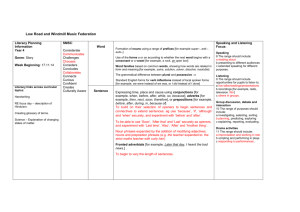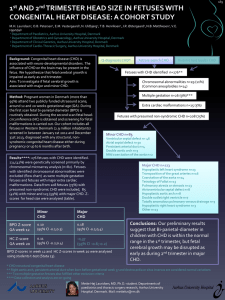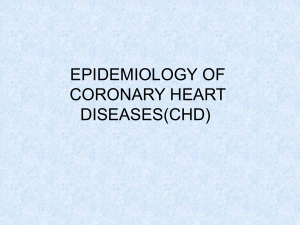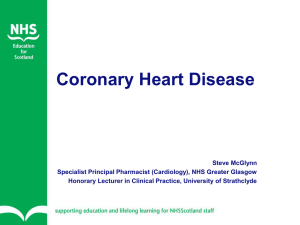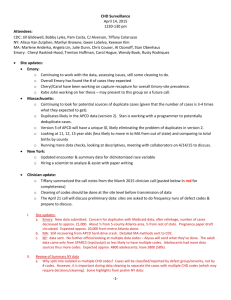Coronary Heart Disease (CHD): A Disease of
advertisement
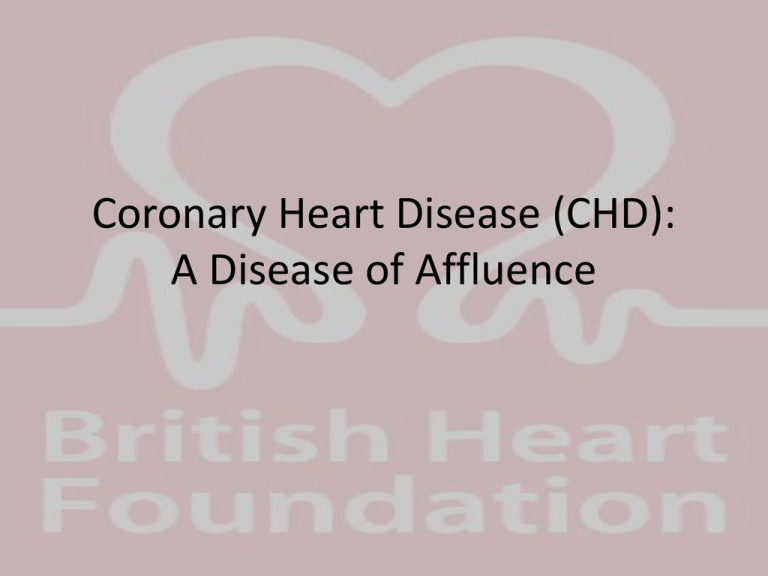
Coronary Heart Disease (CHD): A Disease of Affluence Lesson Objectives 1. I understand what CHD is 2. I understand what ‘affluence’ factors contribute to CHD 3. I know what the distribution of CHD is within the world and the UK 4. I know what the effects of CHD are and what can be done to reduce the problem Starter- Draw a Picture of Someone with CHD 1. I understand what CHD is A heart attack occurs when the blood vessels supplying the heart muscle become blocked, starving it of oxygen and leading to the heart’s muscle failure or death. Measured in DALYs which are the number of healthy years lost to the disease and gives an indication of burden which is better than death rate http://www.bbc.co.uk/learningzone/clips/coron ary-heart-disease/5700.html 2. I understand what ‘affluence’ factors contribute to CHD Around 80-90% of deaths from lung cancer are caused by smoking. Smoking is estimated to account for two-thirds of the social class difference in deaths in men. The Leeds Lifestyle Survey (2002) found smoking prevalence in the city of 26.2% (16-75 year olds) and 38.6% in younger people (16-24 year olds). Although (from survey results) Leeds North East has the lowest proportion of those aged 16-74 who smoke of the Leeds PCT areas, this still equates to over 18,500 people. Benefits of stopping are well known – these include reduction in risk of lung cancer, chronic chest disease and coronary heart disease (CHD). The CHD risk starts to reduce immediately and excess risk is halved in 12 months. Increasing body weight has been linked to chronic diseases such as: “coronary heart disease (CHD), type 2 diabetes mellitus (DM), hypertension, stroke, and cancers of the breast, endometrial, prostate and colon” (Must and McKeown, 2008). • “The UK has some of the least thermally efficient housing in northern Europe” (Prevalin et al, 2008, p.680) which can lead to poor respiratory health, hypothermia, heart disease and more (Prevalin et al, 2008, p.681). Risk Factors • 300 risk factor associated with coronary heart disease • Most common are: alcohol use, tobacco use, high blood pressure, high cholesterol and obesity. In LEDCs undernourishment and communicable diseases also lead to CHD • Most of the risk factors can be modified or prevented 3. I know what the distribution of CHD is within the world and the UK • Discuss with the person sitting next to you where you think CHD rates are highest, both globally and nationally Global Distribution • Geographical pattern - WHO states that more than 60% of global burden is in newly developing countries such as Eastern Europe. The next highest levels in MEDCs such as USA and finally in sub-Saharan LEDCs they show the lowest rates • Differences within countries are linked to socioeconomic group. A rise in coronary heart disease in LEDCs historically among the higher socioeconomic groups but this is starting to change. A reduction in MEDCs but only in higher socioeconomic groups Key Facts • Since 1990 more people around the world have died from coronary heart disease than any other cause • Disease burden is projected to rise from 47million DALYs (Disability Adjusted Life Years) in 1990 to 82million DALYs by 2020 • 10% of DALYs in LEDCs and 18% in MEDCs so it is an affluent disease 4. I know what the effects of CHD are and what can be done to reduce the problem Economic Costs • These include costs to individual of health and time off work and to the government with loss in productivity and cost of health care.. Eg. Health problems related to obesity such as heart disease cost the USA US$177 billion a year! (WHO) Prevention Strategies • Promotion of eating ‘5 a day’, less saturated fat and more oily fish • Community based interventions in Finland and nutrition labeling have helped to reduce heart disease • In Japan, health campaigns and increase treatment of high blood pressure • New Zealand have use logos on healthy food • Mauritius have changed from palm oil to soya oil for cooking Health Education • Since 2000 World Heart Day led by WHO • Medical activities such as blood pressure testing • Engage public in physical activity – Sport Relief • Scientific conferences Policies and Legislation • Only governments can legislate for the prevention of/ control of the disease Eg. Smoking bans, advertising, taxation Plenary Task- Answer the following questions… • What is CHD? • What factors increase the likelihood of getting CHD? • Why is CHD called a disease of affluence? • What is the global distribution of CHD? • What is the UK distribution of CHD? • What can be done to reduce CHD rates?


